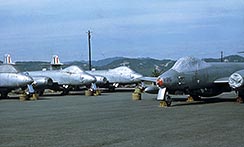Ceasefire at Panmunjom, 27 July 1953
Overview of the ceasefire process

Kunsan, Korea, March 1954. Meteor Mk 8 aircraft of No. 77 Squadron, RAAF, all with protective covers on their canopies and air intakes. From left to right: A77 703, A77 17, unidentified, and A77 886. These aircraft returned to Sydney on 3 December 1954. [AWM P02829.006] ... Enlarge the image of the Meteor jets
Often one or both sides realise that they do not have the strength, or are not willing to play the price in lives and money, to occupy the enemy country and dictate the peace terms. After a period of fighting it sometimes becomes apparent that a negotiated peace is the best that can be obtained.
Within months of the Chinese intervention in the war in October 1950, the United States came to the conclusion that it would be too difficult to defeat the new and powerful enemy, and that a negotiated peace was a better option. Its United Nations allies agreed though South Korea opposed the decision. The communist countries took another six months to come to the same conclusion. Negotiations began on 10 July 1951 and continued for two years until a ceasefire was agreed to on 27 July 1953. By then almost a million uniformed personnel from both sides, and two million civilians, had died. Australia lost 339 dead and 1216 wounded.

Chinese soldiers silhouetted on the skyline shortly after the ceasefire. The Chinese soldiers placed red, yellow and green 'peace' flags on the ridge to the left of this small crest. One of a series of photographs taken by the Australian Mr Douglas Bushby in his capacity as a UN-accredited war correspondent. [AWM P04641.180] ... Enlarge the image of Chinese soldiers placing peace flags
After the ceasefire both sides exchanged prisoners and retreated to create a four kilometre wide demilitarised zone. The remains of more than 20,000 dead were exchanged. None of the 44 Australians missing in Korea were among them. An agreement to halt military operations did not mean that political questions had been settled. Negotiations for a permanent political solution in Korea continued for two years while both sides maintained strong forces on the border. Defences were strengthened and there were violations of the ceasefire that resulted in fighting. At least for the first year there was a feeling that the war could erupt again, but it never did. The final conference to find a way to peacefully re-unify Korea was held in Geneva, Switzerland from April to July 1954. The negotiations achieved nothing.
In late 1953 Australia had agreed to contribute a force to the newly proposed Far East Strategic Reserve in Malaya. To do this it was necessary to withdraw troops from policing the armistice in Korea. This began in late 1954 and by 1957 there were no Australian military units in Korea, ending a seven-year commitment.

Teaching and learning activities for the classroom
Ceasefire at Panmunjom: Casualties

North Korea, October 1950. The treatment and evacuation of wounded Australian soldiers. Photographer, Alan Lambert. Donor R. Trebilco. [AWM P00675.088] ... Enlarge the photo of the wounded soldiers
Part A
Look at the downloadable photograph and answer these questions.
The photograph shows some of the 1584 Australians wounded in the Korean War. Examine the photograph closely. Think about it, then answer the following questions.
- Do you think the man without a hat is wounded? Can you see any evidence that he is?
- Look at the faces. Can you identify any particular emotion on them?
- What do you think happened immediately after the photograph was taken?
- Would you feel differently about the photograph if the wounded men were Koreans?
- How can you tell whether or not the photographer came across the scene by chance or posed it?
Part B
Now read the text and look at the list of casualties then write answers to these questions.
- The Australians fought in the 1st British Commonwealth Division with British (United Kingdom), Canadians and New Zealanders. What was the total number of casualties (dead, wounded and captured) for the whole division?
- Which country lost the most dead and which had the most captured?
- Koreans fought on both sides. What was the total number of Koreans wounded in the war?
- What kinds of casualties are not on the list?
- Why are some kinds of casualties only estimates? Why is it we will never know the accurate numbers in some cases?
Links:
Ceasefire at Panmunjom: Casualties of the Korean War
Stalemate, the war in 1952–1953: Australian Medical Services



















